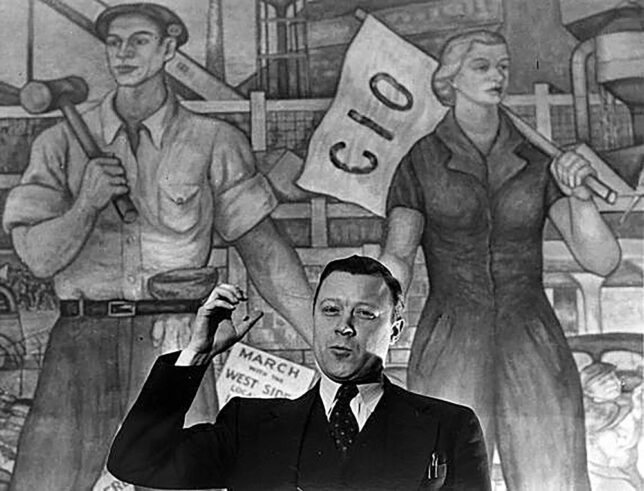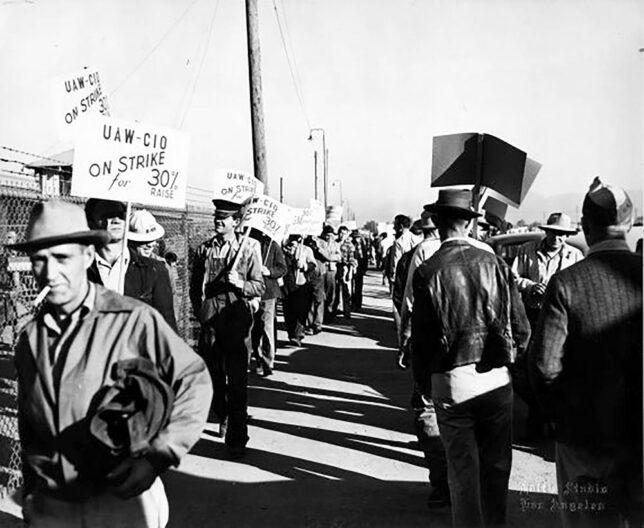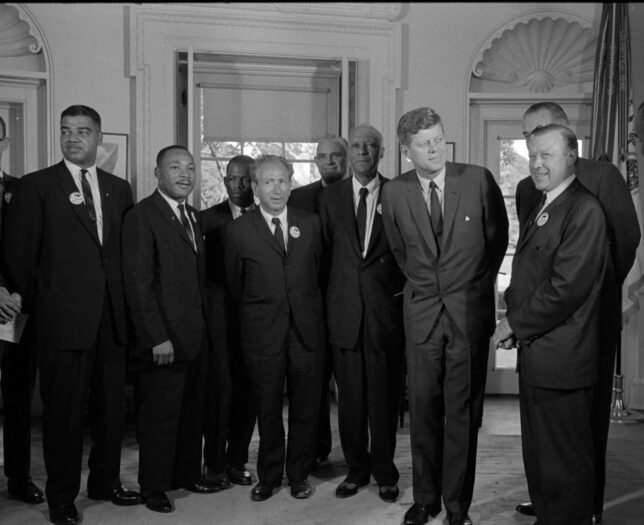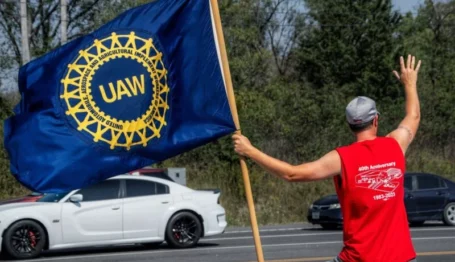Labor Watch
Big Labor’s Decline and Left Turn: Labor’s Private-Sector Left
 Walter Reuther would make his name leading the “sit-down-strikes” in the 1930s against the Detroit Three automakers that secured union recognition. Credit: Works Progress Administration. Public domain.
Walter Reuther would make his name leading the “sit-down-strikes” in the 1930s against the Detroit Three automakers that secured union recognition. Credit: Works Progress Administration. Public domain.

Big Labor’s Decline and Left Turn: The Government Workers Rise and Labor’s Center Falls (full series)
A New Power Rises | Labor’s Private-Sector Left | Causes of the Long Decline
A Trade Unionist in the White House | Membership Decline
Labor’s Private-Sector Left: Walter Reuther and Unionism’s Activist Wing
But in the 1960s, government worker unionism subordinating the wider labor movement was still decades away. The Left of organized labor (laying aside some straggling outright communists and fellow-travelers like International Longshore and Warehouse Union president Harry Bridges) was led by Walter Reuther, head of the United Auto Workers and the motivating force of the Industrial Union Department of the AFL-CIO.
By 1960, Reuther was already a veteran of decades in union organizing. The son of a socialist trade unionist from West Virginia, Reuther and his brothers took to industrial unionism, the practice of worker organizing across trades within the same industry. By the early 1930s, Reuther had campaigned for Socialist Party candidate Norman Thomas and worked abroad in a tool-and-die factory in the Soviet city of Gorky (now Nizhny Novgorod, Russia). Returning to the United States in the mid-1930s, Reuther would make his name leading the “sit-down-strikes” in the 1930s against the Detroit Three automakers that secured union recognition.
But while Walter Reuther had made his name securing recognition for the UAW, his 1946 strike against General Motors would propel him to the leadership of his union and organized labor’s liberal wing. The immediate postwar period was when Big Labor attempted to flex its New Deal–empowered muscles; Reuther’s GM strike was its most audacious bid. While other CIO unions (most notably the United Steelworkers) struck for wage increases to stay ahead of rising inflation, Reuther’s UAW added unprecedented demands on the automaker’s business including a union veto over vehicle price increases.

While his 1945–46 strike failed beyond securing a wage increase and helped provoke the conservative reaction of the Taft-Hartley Act, Walter Reuther increased his status in the CIO. Credit: Halt’s Studio. License: https://bit.ly/3OcxRoa.
While his 1945–46 strike failed beyond securing a wage increase and helped provoke the conservative reaction of the Taft-Hartley Act, Reuther increased his status in the CIO. His subsequent 1948 bargaining round with the automakers created a wage formula and corporate social policy that prospered in the 1950s and 1960s but later drove inflation and hurt Detroit’s competitiveness in the 1970s.

Walter Reuther’s social democracy played out in two major areas. Unlike AFL-CIO head George Meany, Reuther was a strong backer of Martin Luther King Jr.’s civil rights campaigns. (Civil rights leaders meet with President John F. Kennedy and Walter Reuther in the White House after the March on Washington, August 28, 1963.) Credit: Warren Leffler. License: https://bit.ly/3Srfoa8.
Reuther’s social democracy played out in two major areas. Unlike AFL-CIO head George Meany, Reuther was a strong backer of Martin Luther King Jr.’s civil rights campaigns. (While personally supportive of the civil rights movement, Meany did not institutionally back campaigners like King in the interests of managing a giant coalition that included segregationist Southerners and Black Pullman-car porters alike.) At one point Kennedy administration Attorney General Robert F. Kennedy even called Reuther to arrange payment of an extortionate bail amount that an Alabama court had set for King. Reuther would be the highest-profile white organizer supporting the 1963 March on Washington for Jobs and Freedom, at which King delivered his “I Have a Dream” speech.
On economics, Reuther’s results were more mixed. His 1946 strike for something approaching European-style “co-determination” failed and helped provoke a conservative reaction, but the “Treaty of Detroit” his union negotiated with General Motors in the 1948 and 1950 bargaining rounds created a form of privatized social welfare for union members that midcentury liberals would view as a model to expand nationally. The model would prove reasonably successful until the 1970s, during which inflation, declining productivity growth, and competition from foreign competitors recovering from World War II exposed the weakness of this labor Keynesianism.
But a mere private system of social provision for union members was not all the left-wing Reuther was after. As in 1946, he sought to remake American society on the state-socialist Scandinavian model of his time. (Contemporary Scandinavia has abandoned the state-socialist model of its mid-20th century for a hybrid of liberal, open trading economy appended to a comparatively gigantic, high-middle-class-tax welfare state.) His UAW supported the rise of the New Left. Reuther’s aide Millie Jeffrey helped arrange the venue and financing for the conference at which the Port Huron Statement, the New Left’s manifesto, was drafted and adopted. The UAW under Reuther also provided at least $10,000 in funding (roughly $101,000 in 2023 dollars) to the budding Students for a Democratic Society activist group.
Reuther’s hostility to George Meany, the long-standing head of the AFL-CIO, ultimately led to a break in the late 1960s. Reuther had become increasingly critical of Meany’s aggressive Cold War foreign outlook (which aligned with the policy of the Johnson administration), especially the AFL-CIO’s collaboration with the Central Intelligence Agency. Reuther favored contacts with the Eastern Bloc and balked at the escalation of the war in Vietnam.
Departure from the AFL-CIO put Reuther’s UAW in the company of a strange bedfellow. Reuther himself was famously “clean” by the standards of the labor union leaders of his time; during the Rackets Committee investigations, committee Republicans had embarrassed themselves with sloppy inquiries that failed to show misconduct at the UAW. But after departing the AFL-CIO, Reuther teamed up with the Rackets Committee’s number-one target: the Teamsters, led de facto by Frank Fitzsimmons, allegedly a Mob-compromised figure himself, while the Mob-compromised and occasionally Republican-friendly Jimmy Hoffa was jailed.
In 1968, the two unions joined up in the Alliance for Labor Action (ALA). In a harbinger of labor’s messaging over the Long Decline to come, at its inaugural convention ALA vowed to “revitalize the labor movement” while organizing unorganized workers and campaigning for expanded social welfare programs.
But Reuther would not live to see the Long Decline take hold. In May 1970, Reuther, his wife, and two other passengers boarded a Learjet 23 bound for the UAW’s recreation and education center at Black Lake, Michigan. On approach, the pilot lost situational awareness of his altitude. The aircraft struck trees and crashed into flames. All souls aboard were lost.
In the next installment, by the 1970s organized labor had begun its long decline.



